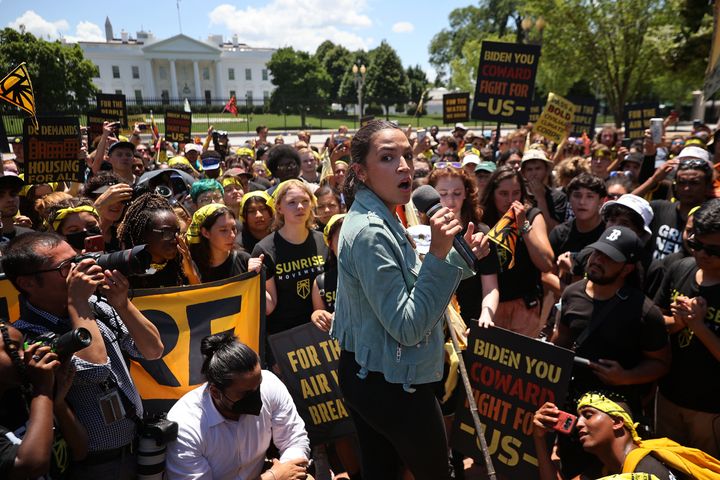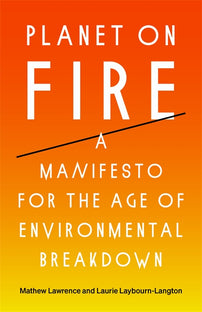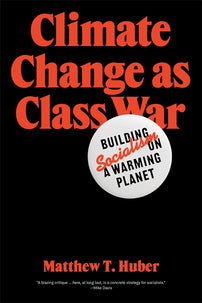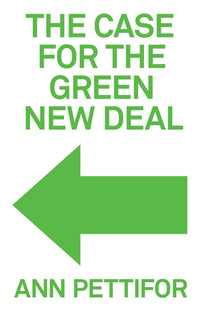No Hollywood Ending for the Green New Deal
A new documentary, To the End, credits the political activists behind the Green New Deal movement for Biden’s environmental policies. Yet, as Matt Huber writes, the film fails to acknowledge that the inability of green activists to build a mass base was also the cause of the Inflation Reduction Act's limitations.

Does the Inflation Reduction Act (IRA) constitute a win for the Green New Deal movement? That is the gambit of the new documentary To the End chronicling the rise and climax of the movement from 2018 to the present. The film traces this history through the lens of two organizations – the Sunrise Movement and Justice Democrats – and four women, Varshini Prakash (Sunrise), Congresswoman Alexandria Ocasio-Cortez, Alexandra Rojas (Justice Democrats) and Rhiana Gunn-Wright (formerly New Consensus and now climate policy director at the Roosevelt Institute).
As activists have pointed out, it’s undeniable the IRA was partially a product of the sustained pressure and organizing of this movement. These same activists would, however, concede that the progressive gains of the IRA are also woefully inadequate: the law does not meet the scale and urgency of the climate crisis and does almost nothing on the other crisis the GND purported to address: economic inequality. The IRA is instead largely a package of tax credits meant to ‘derisk’ private investment and consumer purchases, it is a far cry from the revival of public investment and union power the original New Deal represents.
The Limits of The Possible?
Perhaps the IRA represents the pinnacle of what the GND movement, such as it is, can achieve. In a very telling moment near the end, Rojas vents that surely, we will see “some sort of mass response at some point” to the climate crisis. Yet, it is the absence of any kind of mass politics itself that haunts the movement throughout the film. Determined activism must take its place through moral suasion of political elites over the direness of climate breakdown – youth protestors chanting slogans like “We want to live!” as a largely indifferent Joe Manchin drives away in his fuel-guzzling car.
On a Thursday afternoon in a large theatre in Syracuse, NY I was the lone viewer of To the End, a film which was released on December 9 in over 120 theatres across the United States. My experience was representative of national trend. During its opening weekend, Black Panther: Wakanda Forever was number one, grossing over $11 million dollars during its fifth weekend in theaters. To the End drew in precisely $9,694 (or $81 per theater). The horror film, Smile, in its eleventh week in theatres made over 10 times as much the same weekend. Of course, these are not ideal metrics for basing judgments on merits of a film, but the lack of popularity of To the End is, it’s reasonable to assume, not unrelated to the generally marginal nature of environmental politics in the US.
The film gets off to a rough start with the by now cliché epigram from Antonio Gramsci “The old is dying and the new cannot be born.” But instead of the warning of “morbid symptoms” found in the standard translation of the Sardinian, the next line is: “in the meantime, all kinds of dreadful things are happening.” Putting quibbles around textual fidelity to the side, the focus on the emotional register rather than Gramsci’s cold medical diagnostic tone is revealing of an approach to thinking about climate change common within the environmental movement. What follows are frightening scenes of cascading disaster (culminating in harrowing footage of a car driving through a literal inferno). The disaster footage makes it clear: something must be done. But who will do the doing? Enter our protagonists in the Sunrise Movement.
Professional Managerial Leftism
Alarm is a mood often hostile to self-reflection. Accordingly, the film does little to contextualize the organizations it profiles. Who would ask for the qualifications of a firefighter saving them from a burning building? The disappointments of the IRA and the general failure of a mass environmental movement to materialize nevertheless thrust these uncomfortable questions onto us.
The Sunrise Movement was birthed from the Green NGO complex – specifically a $50,000 grant and office space from the Sierra Club Foundation in 2017. It’s strategy was also concocted deep in the foundation funded NGO world via an organization called Momentum which, on its website, claims to be, “a training institute and community of movement organizers.” Momentum itself received substantial funding from the “nonprofit incubator” the Ayni Institute in addition to thousands of dollars of grants from a variety of wealthy benefactors.
While not downplaying their considerable electoral success, Justice Democrats too is a decidedly top-down organization with no mass membership base or local organizing infrastructure. It was originally formed by left populists like Cenk Uygur and Kyle Kulinski with the goal of harnessing the crowd funding model of Bernie Sanders’s campaign. Their candidates in turn adopted much of his 2016 platform. After Sanders dropped out in 2020, however, Justice Democrats formed its own SuperPac, filing a notice with the FEC announcing it, “intends to establish a separate bank account to deposit and withdraw funds raised in unlimited amounts from individuals, corporations, labor organizations, and/or other political committees.”
[book-strip index="1" style="buy"]The film effectively traces the arc of the movement beginning with the breakthrough Sunrise and AOC sit-in at Nancy Pelosi’s office in November 2018. The sit in, calling for a Green New Deal, effectively catapulted it onto the political scene in the midst of a catastrophic IPCC report (misreported as claiming we have 12 years to save the planet).
What happens next though is more befitting of the contemporary left embroiled in NGOs and the professional managerial class. We see Gunn-Wright’s “New Consensus” launch a strategy conference at what appears to be a typical fancy conference ballroom. Many of the community groups present at Gunn Wright’s conference start calling out the “process” for silencing certain voices and perspectives leaving Gunn Wright in the end frustrated if undaunted.
Sunrise appears more scrappy in their NGO-provided office space. For reasons unexplained, some of them sleep there. Using white boards and PowerPoint presentations they lay out their theory of change. Its key ingredients are disruption and “people power.”
The rollout of the Green New Deal is anchored by AOC and Ed Markey’s February 2019 launch of the non-binding Congressional resolution. The film shows the right-wing ridicule of the Green New Deal as taking away the right to hamburgers. Even the bland liberal, and Daily Show host, Trevor Noah takes a shot claiming the Green New Deal promises free health care, a guaranteed job and getting your parents back together.
What the film excludes is that much of this ridicule was self-inflicted; the product of a catastrophic FAQ document circulated by AOC’s office during her GND media blitz. The document, apparently written hastily by her chief of staff, Saikat Chakrabarti, is a bizarre almost stream-of-consciousness piece of writing. It became notorious for its extreme vision of climate austerity that included banning “farting cows and airplanes” and moving toward 100% intermittent renewable energy.
[book-strip index="2" style="buy"]Having said all of this, in 2019, it’s clear the movement had momentum. In the film, Prakash cites Sunrise rise from 20 to 300 chapters nationwide, and their involvement in the organizing of the mass 2019 climate strikes. The Green New Deal was all the talk in progressive circles, and the victory of AOC and other Justice Democrats squad members raised the movement into the limelight. A particularly strange theme in the film is the multiple scenes devoted to the stress that Justice Democrats Executive Director, Alexandra Rojas, goes through in prepping for CNN appearances.
Sunrise also wisely created a mass, democratic process to overwhelmingly endorse Bernie Sanders’ 2020 campaign. A particularly tear jerking private moment occurs in the film between when Sanders tries to explain to Prakash the enormity of the challenge ahead of them. It is, he says, “much harder than even the depression.” “We can’t save [the planet] alone, we have to get the world involved.” Prakash says she understands, and they embrace, as Sanders tells her he loves her “youthful optimism.”
Lost in the Halls of Power
What becomes clear though, is that the movement had confused the public attention on the Green New Deal for organizational power. PR campaigns, however popular, are not political movements. In the end, they banked much of their strategy on the electoral terrain – endorsing numerous Congressional candidates and ultimately placing hopes on the Presidency who could wield tremendous executive power on climate. When the defeat of that campaign combined with a global pandemic-induced shut down of all activism, the movement becomes demoralized. The film shows the Sunrise activists shedding tears and sharing political reflections when they recognize the scale of their defeat.
In a left embroiled in NGO-based “movementism” for decades, arguably the only attempt at a mass politics that contests for power was Bernie Sanders’ Presidential campaigns. The GND movement successfully hitched their wagon to that form of mass politics, but when it failed it turned back to “movementism”.
By 2021, Sunrise in particular engaged in a number of direct action tactics, like a long march, blocking entrances to the White House, and a hunger strike, but none appear in the film to be “mass actions” undertaken with more than tens or, at most, hundreds of people (again, to be sure, COVID constraints played a role).
[book-strip index="3" style="buy"]Moreover, in each of these movements, the original focus of the GND on universal public goods — jobs, health care, decommodified basic needs — fell to the wayside and a set of niche demands emerged in their place. Calls for a Civilian Climate Corp became prominent despite garnering only tepid enthusiasm from unions. Likewise, the campaign demanded that forty percent of GND investments be directed toward means-tested programs for disadvantaged communities as part of an environmental justice initiative. It was not clear how these demands would help generate a base for a mass working class politics nor how their “direct action” was in any way comparable to the 1930s strikewave that won much of the original New Deal (The film’s stock footage of 1930s stands in stark contrast to the Sunrise actions of 2021).
If the public attention to the GND was mistaken for power in the first phase, the next phase, in the words of Jane McAlevey, “confused access for power.” In the Summer of 2020, Prakash and AOC were included in Biden’s Climate Unity Task force which deeply influenced the more ambitious nature of Biden’s general election climate plan. A campaign plan is not, of course, an actually implemented climate policy. By luring Sunrise – and AOC for that matter – into an “inside game”, Biden effectively neutralized the movement. Once Biden was in office, they were drawn into an eighteen-month marathon of Congressional negotiations and Joe Manchin psychodrama that slowly eviscerated the ambition of a $3.5 trillion Build Back Better package.
To be clear, the film is honest about the limits of the movement’s claimed success: the Inflation Reduction Act. But, as was the case in the progressive assessment at the time, the flaws of the IRA are simply presented in terms of how it includes benefits for the fossil fuel industry. There appears a general reluctance to point out the inherent policy limits of the supposedly “good” things about the IRA – using the tax code to incentivize low carbon market action by investors and consumers alike. The cornerstone of the Green New Deal vision of large-scale public investment and decommodified public goods are gone.
The idea that the climate crisis requires a massive political confrontation with the owners of fossil fuel capital is also not only completely off the table, but quite the opposite of the aims of the Biden administration. The current president is more prone to criticizing the fossil fuel industry for not producing enough! Meanwhile, two months ago, ExxonMobil reported record profits once again, and their CEO Darren Woods, shrugged his shoulders in the face of criticism, claiming the American people will share in the wealth from their dividend payments.
On a couple occasions in the film AOC and Sunrise activists explain their activism is rooted in faith; a conviction that even though change seems impossible, the struggle will eventually yield results. A more serious political movement would demand a return to Sunrise’s original commitment to mapping out a theory of change and a strategic plan to win.
Overall, the film provides a bleak picture a mere four years since the inspiring Pelosi sit in. The IRA hardly makes for a Hollywood ending. It ends on an optimistic tone, however, with the text on the screen claiming the IRA is the largest climate investment in history – and that it is “only the beginning.” Yet, as it is currently constituted among committed youth activists, academics and NGO staffers, how the movement can actually grow its power is not at all clear.
Matt Huber is a professor of geography at Syracuse University. His new book, Climate Change as Class War: Building Socialism on a Warming Planet, is out from Verso Books in 2022.
[book-strip index="4" style="buy"]


